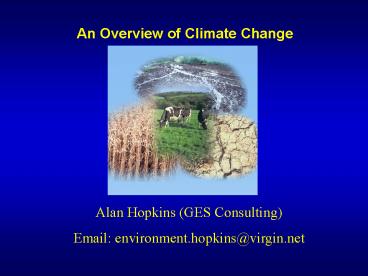An Overview of Climate Change - PowerPoint PPT Presentation
1 / 14
Title:
An Overview of Climate Change
Description:
Possible effects on agriculture and land use : how resilient are we? ... Some benefits from climate change from milder 'average' climate and increased CO2. ... – PowerPoint PPT presentation
Number of Views:62
Avg rating:3.0/5.0
Title: An Overview of Climate Change
1
An Overview of Climate Change
Alan Hopkins (GES Consulting) Email
environment.hopkins_at_virgin.net
2
Outline of talk
- Climate change and greenhouse gases evidence of
recent trends in climate change and anticipated
future trends. - Possible effects on agriculture and land use
how resilient are we? - Adaptations and possible measures to reduce
climate change - Opportunities for UK farms and businesses
- Possible threats and the need to plan ahead
3
Terminology
- Climate change and global warming
- The Greenhouse effect
- Greenhouse gases
- Climate change scenarios
- Adaptations and mitigations
4
Greenhouse gases
- 100-yr GWP Concentrations now and 200 years ago
- CO2 1 374 ppm (280)
- Methane 23 1745 ppb (700)
- Nit. oxide 300 314 ppb (270)
- CFCs 4000 268 ppt (zero)
5
Agricultures contribution to greenhouse gas
emissions in UK
- 1 of carbon dioxide
- 30 of methane (enteric fermentation / manure
management) - 60 nitrous oxide (soils and fertilisers).
- 8 direct greenhouse gas emissions in the UK
- UK agriculture part of the problem but is part of
the solution
6
21st Century climate change in UK ?
- Warmer (1-5oC depending on region) and especially
in summer and autumn - Regional differences warming greater in SE than
NW - Little change in overall annual rainfall but
increased frequency of wetter winters and of
drier summers - More variability in winds, storms, droughts
7
How resilient are existing cropping systems?
- Warmer, drier summers increased probability of
drought stress (sugar, potatoes, veg crops) - Risks of damage from increased storminess (soil
erosion, standing crops, orchards, glass) - Wetter winters and storms establishment of
winter-sown crops and fields ops in general. - New pests and diseases and earlier attacks.
- Problems for glasshouse controls.
- New crops and varieties risk management (mix
water supplies maintain soil structure)
8
- How resilient is forage /livestock production to
climate change ? Adaptations - Elevated CO2 and temperatures longer growing
season () heat stress (--) - Changes in seasonal distribution of rainfall
(field operations, silage, grazing) - Increased winter wind speed (buildings, stock)
- Increased risks of extreme events (forward
planning important) soil, water, feed, shelter,
shade, standings - Opportunities more legumes, forage maize, whole
crop
9
Likely future pressures for farmers to mitigate
impacts of climate change what are the options ?
- Improved management of manures, fertiliser, soil
and water to conserve water supplies, protect
soil quality and reduce net gaseous emissions. - Increase carbon sequestration in soils, grass and
other farmland vegetation (possibly with future
carbon emissions trading). - Renewable energy crops to displace fossil fuels
and at same time remove GHGs from atmosphere. - Many low-cost options can be implemented now.
10
Management to mitigate greenhouse gas emissions
CH4
- Reduce emissions from enteric fermentation
through dietary change, rumen manipulation, or
systematic changes (active research
internationally). - Reduce emissions from manure through better
management (oxygen supply/ covers) or use manure
in anaerobic digestion as energy source
potentially very important in future
11
Management to mitigate greenhouse gas emissions
NO2
- Improving fertilizer efficiency
- Optimizing methods and timing of applications
- NH3-based fertilizers rather than NO3 or use
nitrification chemical inhibitors - Increasing the soil aeration improving drainage
on grazed grassland, and avoiding compaction by
traffic, tillage and grazing livestock. - Minimizing the grazing period
12
Management to mitigate greenhouse gas emissions
CO2
- Maintain permanent pasture, and reduced tillage,
rather than annual cultivations. - More forage leys in existing arable rotations.
- Increase soil organic matter through additions of
manure etc. - Maintain and prevent drying out of peaty soils.
- Reduce farm fuels and other C inputs
13
New farm-scale opportunities?
- UK more resilient than some other areas, so
global effects on world agriculture could benefit
UK farmers. - Some benefits from climate change from milder
average climate and increased CO2. - New crops, including biofuels and industrial
crops, and longer growing season in some areas. - Legumes to offset artificial N inputs (with
important cash savings for farmers). - Potential for Carbon trading for C storage in
soils - Reduce methane emissions from livestock manures
through biodigestion.
14
Conclusions
- Convergence of the food economy and the energy
economy, plus wider environmental goals ? a need
for integrated approaches. Global effects on
world agriculture, and energy security issues
will benefit UK farmers. - Potential for increased crop and forage yields
due to climate warming CO2, especially legumes,
but regional problems of droughts. - Uncertainties remain. Consensus that we plan to
adapt to anticipated change and to mitigate the
probable causes (GHGs) at the farm scale. - Plan for uncertainties through more conserved
feeds and mix of crops and harvest / sowing
times. Multi-purpose land use. - .































